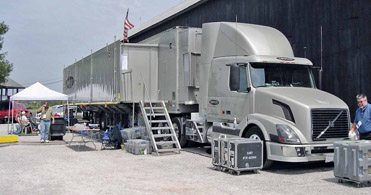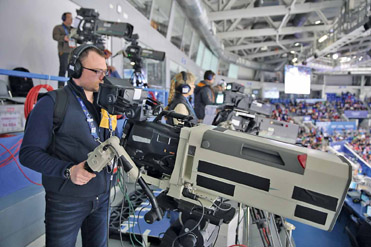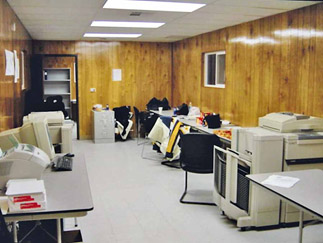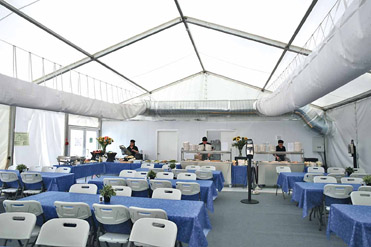Chapter 17
Budgeting for the Remote
A budget is very similar to a site survey but is really a numeric evaluation of the production plan.
Hank Levine, CFO, Olympic Broadcasting Services
While television sports production is an enjoyable passion for many in the business, bottom line, it is a business. There are a number of ways that television sports productions get broadcast. We will refer to the organization that broadcasts the programming as a chan nel. However, we are using the word “channel” to refer to any of the following: broadcast network, broadcast station, cable channel, or any entity on the Internet that distributes programming. While there are variations of the following, these are the most common ways:
- A channel can send their own staff to produce the event.
- A channel can pay a production company to create the production for them.
- An event can pay to have its own event produced and broadcast.
- An advertiser/sponsor can pay a production company to create the production and then pay or share advertising money with the channel.
- Production companies can find their own sponsors, create their own production of the event, and then either sell it to the channel or buy time on the channel. The event in the case study below could be sold to a national network for around $165,000.
Budgeting Case Study
Budgeting for remote productions varies greatly from event to event. We chose to use a medium-sized event as our television production budget case study. This way, smaller production personnel can review the costs of a medium production and adapt them for a smaller event.
For this rough production budget, we have assumed that a freelance crew has to be hired and a large mobile unit/OB van needs to be rented. The event, a small auto race, will require three days on site and the final product will be two hours of programming shown on a national network. The amounts shown are based on 2015 costs in the United States and are given as an example for studying the budget process.
Equipment Rental
- Mobile unit/OB van: $19,500
This cost ($12,000–15,000/day) generally includes eight cameras (some handheld and some hard cameras), truck personnel (EIC, maintenance engineer, and driver), and the cost of transporting the unit to the location (see Figure 17.1). - Cameras: $650/one additional camera The cost for cameras that are in addition to the cameras that come with the truck are generally around $500–800/camera (for equip ment only). However, keep in mind that every camera the producer adds requires addi tional cable, possibly an additional microphone, and a cameraperson (daily pay, per diem, flights, and lodging). This additional cost of a camera rapidly moves from $500+ per camera to approximately $2,400+ per camera if you have to use outside, non-local personnel (see Figure 17.2).

Figure 17.1
At least one truck engineer is included with the rental price of a mobile unit.

Figure 17.2
The actual cost for renting a camera depends on the type of camera (handheld, hard, or specialty), the lens needed, and any support gear required.
- RF unit: $18,000
Wireless audio and video equipment is being used more often in remote productions. Most RF trucks can cost about the same as the mobile unit. Cost is dependent on the amount of gear required for the production. This quote is for two handheld cameras and a microphone. - Uplink truck: $6,800
Uplink trucks are available in C-band (lower transponder frequencies) and KU-band (highest frequencies used by satellite transponders). A KU-band truck is $2,400 for the first day and $1,200 for each additional day. A C-band truck generally rents for less than a KU-band truck. The truck’s staff comes with the truck and is included in the cost. This cost includes $1,300 for the satellite rental time. Time is booked in advance of the production by the hour. This event will require two hours plus an additional 30 minutes before airtime for tests. Additional time is usually scheduled in case the event goes into overtime. - Generator: $14,000
Redundant twinpack that includes fuel. - Graphics
Many productions require rental of additional graphics equipment. Again, adding graphics equipment increases the number of staff required, thereby increasing per diem, lodging, and transportation costs. For our sample production budget, we will not be incorporating any additional graphics. - Lighting
Some productions will require additional lighting for the commentator booth or on the field of play. For our sample production budget, we will not be using additional lighting.
Crew Costs
- Approximate personnel cost: $90,000
Personnel costs vary based on whether you are using in-house or freelance personnel. Whether you hire local or non-local personnel will also impact the budget. As mentioned in the camera section, non-local personnel may be more expensive when you include the daily rate, per diem, lodging, flights, and on-location transportation. However, non-local people may actually provide an overall savings to the production if they know the series, setup, and what is needed. Having “core” personnel that travel can make for a much more efficient and creative program as more time can be devoted to content development and less to setup and troubleshooting. A basic crew needed for our case study of a three-day, on-location production providing two hours of network programming is as follows. Keep in mind that these are approximate costs used only for preplanning purposes. The actual cost will vary depending on the location of the event. See the “Approximate Salary of Television Sports Production Crew” box below for more details.
Overtime, if not watched carefully, can turn into a very large amount of money. It can be incredibly difficult to estimate. It usually depends on how familiar the crew is with the venue, weather, and unexpected equipment difficulties. - Per diem: $10,000
Per diems average $50 per person per day for non-local personnel. Per diems cover the crew’s incidental costs while on the road, such as laundry and food. - Housing: $27,000
Generally, $120/night is budgeted for each crew member to have their own room. The budget for 53 crew members for three days would total around $90,000. However, in addition to providing housing for the production crew in our personnel list, the production company is also usually responsible for providing housing for the mobile unit crew (three or more people) and the uplink truck crew (one person). - Transportation
- Flights: $16,500 average
- Rental cars: $4,300
Roughly 15 cars will be required for three days. All senior personnel and talent generally require a car.
Operational Costs
- Catering: $3,000
Generally, catering is provided only on the actual day of the competition. This also includes drinks and snacks. However, it is often worth catering the day before the event so that you do not lose your crew for two hours if they need to go off-site to find restaurants. - Office trailer: $3,000
Trailers may need to be rented to house production and operations personnel. - Scaffolding: $4,500
- Tent, tables, and chairs: $3,640/three days Includes a large catering tent (including setup and tear down), 50 chairs, and 10 tables (see Figure 17.3).
- Golf carts: $5,400
This cost would include 12 golf carts for three days. - Telephone/Internet: $1,600
- Phone lines, long distance, and DSL: $1,500
- Media storage: $1,500
- Wardrobe: $1,000
Hats and shirts for crew and possibly additional clothing for the talent. - Production insurance: $3,750 for one event Many companies who do remote productions on a regular basis pay an annual policy that covers all productions for the year. An annual policy would substantially reduce the cost of insurance.
- Miscellaneous budget: $1,250

Figure 17.3
An office trailer used by the remote production staff.

Figure 17.4
A catering tent from a large production.
- Production supplies: $1,000
- Office supplies: $250
- Security: $750
Covers two security officers to be present during the evenings. They generally receive around $15/hour and are on duty whenever the crew is not at the venue. - Portable restrooms: $1,500
General rule is to provide one facility for every 15 people working at the location. - Overhead: $32,000
A 5–13 percent overhead fee covers the cost of people booking the crew, administration, office space, and related costs. - Production fee: $25,000
The production fee, generally around 10 percent of the budget, is the amount of money a production company would make as a profit for producing the event.
Total Rough Production Budget: $295,000
For three days on-site with a freelance crew and rented mobile unit/OB van.
There are a number of unaddressed items in this budget:
- Is a payroll service going to be used?
- Will a freelance crewing service be utilized?
- Is this a one-time production or part of a series? A series can allow more efficiencies, which results in lower costs compared to a single event.
- Are there management technology requirements such as computers, printer, etc.?
Approximate Salary of Television Sports Production Crew
| # Needed | Position | Approx. Pay/Person | Total per Person | Total Cost |
|
|
||||
| 1 | Line producer | $1,500/day | $6,000 | $6,000 |
| 3 | Pit/tape/feature producers | $450/day | $1,800 | $5,400 |
| 1 | Director | $1,500/day | $6,000 | $6,000 |
| 1 | Associate director | $500/day | $1,000 | $1,000 |
| 4 | Talent | $2,500/day | $7,500 | $30,000 |
| 3 | Production coordinator | $300/day | $600 | $1,800 |
| 1 | Technical director | $600/day | $1,800 | $1,800 |
| 8 | Camera operators | $450/day | $1,340 | $10,720 |
| 6 | Videotape operators | $425/day | $1,700 | $10,200 |
| 3 | Video operator | $500/day | $1,500 | $4,500 |
| 2 | Graphics | $500/day | $2,000 | $4,000 |
| 1 | Font coordinator | $425/day | $1,275 | $1,275 |
| 1 | Senior audio (A-1) | $575/day | $2,300 | $2,300 |
| 4 | A-2 | $420/day | $1,260 | $5,040 |
| 1 | Stage manager | $300/day | $600 | $600 |
| 6 | Utilities | $350/day | $1,050 | $6,300 |
| 5 | Spotter | $250/day | $500 | $2,500 |
| 2 | Runner | $250/day | $750 | $1,550 |
| Total: | 53 crew members | |||
| Total pay: | $90,785 | |||
302 disciplines / 38 sports + 57 digital OB vans × 18 cameras + explosion of the cost of broadcasting facilities – best ever TV coverage + 40 billion viewers × global economic downturn + 40 venues / 3,500 employees – shared crews / venues / equipment + logistics expenses × 3,700 live transmission hours × less is more + quality = budgeting of the Athens Olympic Games.
Anna Chrysou, Deputy Producer, Athens Olympic Broadcasting
Hank Levine, veteran of many sports broadcasts, sums up the budgeting experience like this:
Creating and managing a good working budget requires part foresight, part discipline, and a lot of experience. When developing a project budget, for instance, you need to have a plan for every situation while also realizing that every situation will not actually happen. A budget should be used as a planning tool and, if used properly, it will challenge the team to focus their energies on ensuring that the resources are used in appropriate ways to enhance the production.
(Ben Brown, President, Event Support Services, significantly contributed to this chapter)
